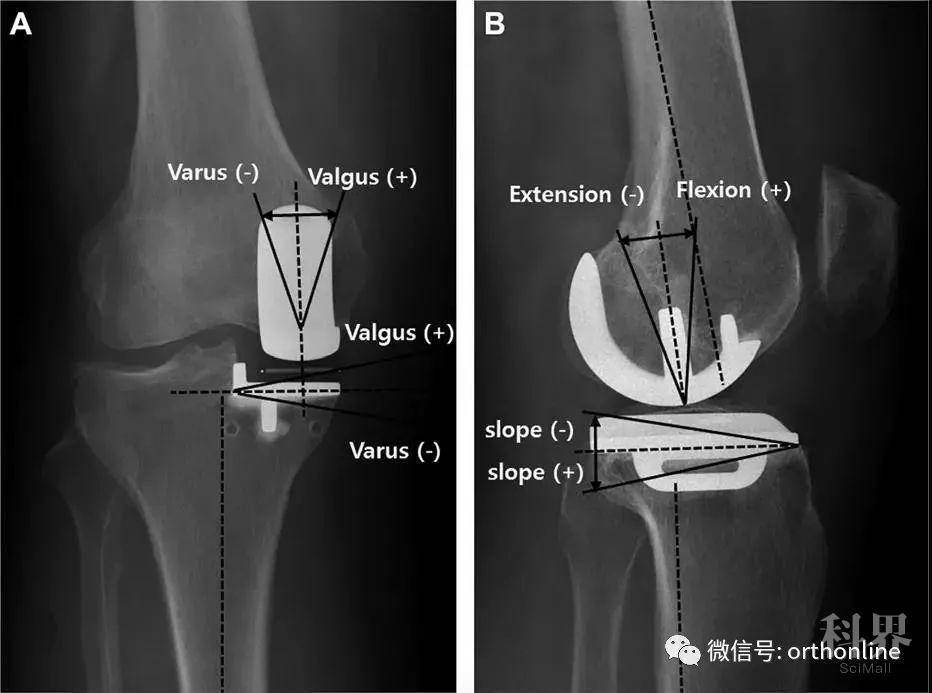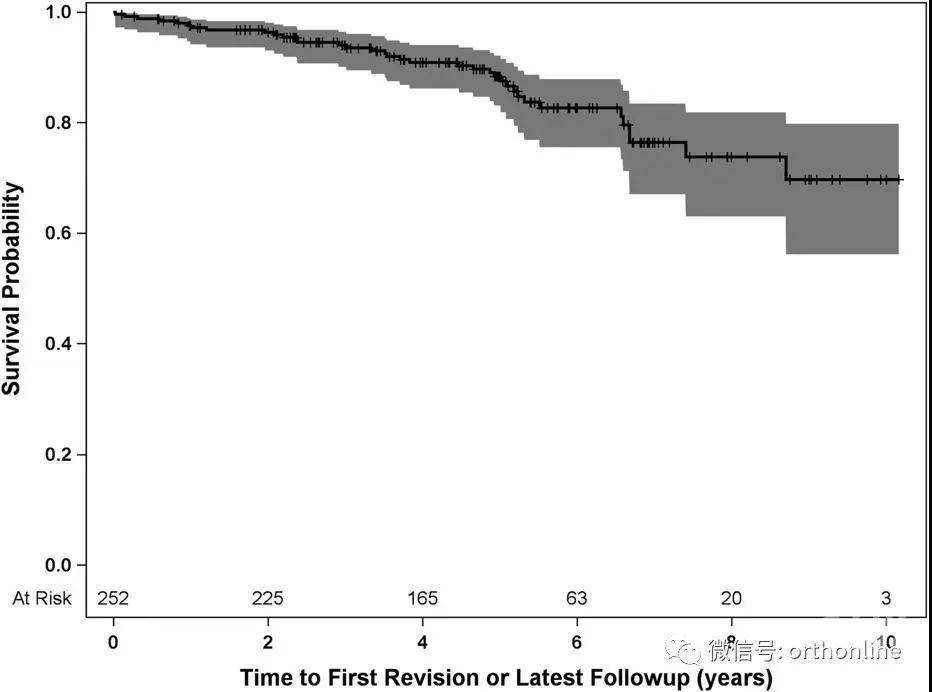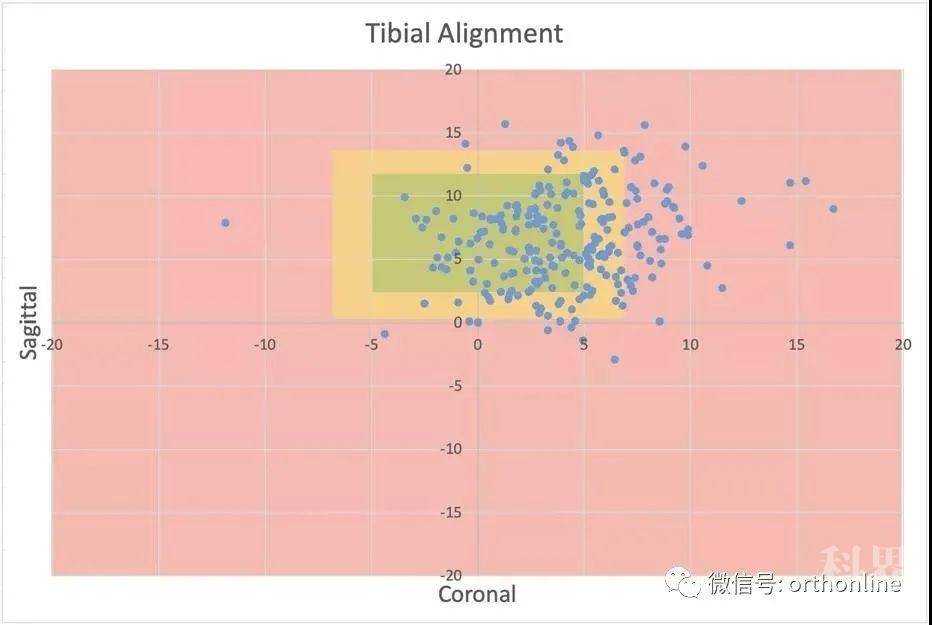纽约特种外科医院Kazarian GS, Barrack TN, Okafor L等近期发表于《J Bone Joint Surg Am》的一项研究显示,单髁翻修与力线异常值的比例显著高于我们的预期,即使术者为每年行14.2例单髁的高手术量医生(高手术量阈值定义为15例每年)亦如此。力线异常和假体悬出是假体失效的显著危险因素。
以往单间室膝关节置换手术(UKA)的力线结果对假体生存率的影响目前并不明确。因此研究人员希望通过本研究评价单髁置换术后的影像学参数对假体生存率的影响,以及假体力线和悬出对假体生存率的影响。

影像学指标
研究者回顾了来自单一中心共253例初次固定平台和活动平台单髁置换手术。所有手术由两名高手术量经正规培训的关节外科医生完成。在他们每年的外科实践中,单髁手术的比例不足10%,平均每人每年行14.2例内侧单髁置换手术。最终我们统计了假体生存率。评价指标包括股骨冠状面成角(FCA),股骨矢状面成角(FSA),胫骨冠状面成角(TCA),胫骨矢状面成角(TSA)和假体悬出。异常值被定义为FCA(偏离中立位±10°以上),FSA(屈曲大于15°),TCA(偏离中立位±5°以上)和TSA(偏离7°后倾±5°以上)。极端异常值被定义为异常值基础上再偏离±2°以上。悬出被定义为前方悬出超过3mm,后方悬出超过2mm,内侧悬出超过2mm。
生存曲线

股骨力线散点图

胫骨力线散点图
结果显示,在单髁失效的病人中,平均翻修时间为3.7年(0.03-8.7年)。累计翻修率14.2%。5年和10年Kaplan-Meier生存率分别为88%(95%置信区间[CI] = 82.0% to 91.0%)和70.0%(95% CI = 56.0% to 80.0%)。只有19.0%(48)的单髁病例位于四项力线参数范围内,只有72.7%(184)的病例未满足三个方向的悬出定义,合并统计只有11.9%(30)的病例力线参数正常且未悬出。与力线正常无悬出的病例(0%)相比,FCA(失效率15.4%,p=0.036)、FSA(失效率16.2%,p=0.028)、TCA(失效率17.9%,p=0.020)和TSA(失效率15.2%,p=0.034)四项参数异常值显著增加假体失效风险。极端异常值同理(p<0.05)。其他影响假体生存的指标包括后方悬出(失效率25.0%,p=0.006)和内侧悬出(失效率38.2%,p<0.001);前方悬出并非危险因素(失效率10.0%,p=0.090)。原文摘要
High Prevalence of Radiographic Outliers and Revisions with Unicompartmental Knee Arthroplasty
Background: Alignment outcomes and their impact on implant survival following unicompartmental knee arthroplasty (UKA) are unclear. The purpose of this study was to assess the implant survival and radiographic outcomes after UKA as well as the impact of component alignment and overhang on implant survival.Methods: We performed a retrospective analysis of 253 primary fixed-bearing and mobile-bearing medial UKAs from a single academic center. All UKAs were performed by 2 high-volume fellowship-trained arthroplasty surgeons. UKAs comprised<10% of their knee arthroplasty practices, with an average of 14.2 medial UKAs per surgeon per year. Implant survival was assessed. Femoral coronal (FCA), femoral sagittal (FSA), tibial coronal (TCA), and tibial sagittal (TSA) angles as well as implant overhang were radio graphically measured. Outliers were defined for FCA (>±10° deviation from neutral),FSA (>15° of flexion),TCA (>±5° deviation from neutral), and TSA (>±5° deviation from 7°). “Far outliers” were an additional >±2° of deviation. Outliers for overhang were identified as >3 mm for anterior overhang, >2 mm for posterior overhang, and >2 mm for medial overhang.Results: Among patients with a failed UKA, revision was performed at an average of 3.7 years (range, 0.03 to 8.7 years). The cumulative revision rate was 14.2%. Kaplan-Meier survival analysis demonstrated 5 and 10-year survival rates of 88.0% (95% confidence interval [CI] = 82.0% to 91.0%) and 70.0% (95% CI = 56.0% to 80.0%), respectively. Only 19.0% (48) of the UKAs met target alignment for all 4 alignment measures, and only 72.7% (184) met all 3 targets for overhang. Only 11.9% (30) fell within all alignment and overhang targets. The risk of implant failure was significantly impacted by outliers for FCA (failure rate = 15.4%, p = 0.036), FSA (16.2%, p = 0.028), TCA (17.9%, p = 0.020), and TSA (15.2%, p = 0.034) compared with implants with no alignment or overhang errors (0%); this was also true for far outliers (p < 0.05). Other risk factors for failure were posterior overhang (failure rate = 25.0%, p = 0.006) and medial overhang (38.2%, p < 0.001); anterior overhang was not a significant risk factor (10.0%, p = 0.090).Conclusions: The proportions of UKA revisions and alignment outliers were greater than expected, even among high-volume arthroplasty surgeons performing an average of 14.2 UKAs per year (just below the high-volume UKA threshold of 15). Alignment and overhang outliers were significant risk factors for implant failure.文献出处:
Kazarian GS, Barrack TN, Okafor L, Barrack RL, Nunley RM, Lawrie CM. High Prevalence of Radiographic Outliers and Revisions with Unicompartmental Knee Arthroplasty [published online ahead of print, 2020 May 8]. J Bone Joint Surg Am. 2020;10.2106/JBJS.19.01277. doi:10.2106/JBJS.19.01277来源:orthonline 骨科在线orthonline
原文链接:http://mp.weixin.qq.com/s?__biz=MjM5NjIyNjk2MA==&mid=2650264068&idx=5&sn=8ae78693f519ece87264125eed20283e&chksm=beef00fb899889edabbb534e625275fb4a1152ae14aab6b41db98440afb0a89d083a40713044&scene=27#wechat_redirect
版权声明:除非特别注明,本站所载内容来源于互联网、微信公众号等公开渠道,不代表本站观点,仅供参考、交流、公益传播之目的。转载的稿件版权归原作者或机构所有,如有侵权,请联系删除。
电话:(010)86409582
邮箱:kejie@scimall.org.cn











